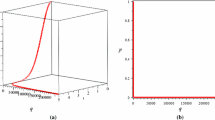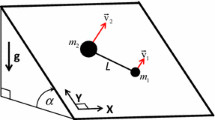Abstract
A geometric analysis of the shake and rattle methods for constrained Hamiltonian problems is carried out. The study reveals the underlying differential geometric foundation of the two methods, and the exact relation between them. In addition, the geometric insight naturally generalises shake and rattle to allow for a strictly larger class of constrained Hamiltonian systems than in the classical setting.
In order for shake and rattle to be well defined, two basic assumptions are needed. First, a nondegeneracy assumption, which is a condition on the Hamiltonian, i.e., on the dynamics of the system. Second, a coisotropy assumption, which is a condition on the geometry of the constrained phase space. Non-trivial examples of systems fulfilling, and failing to fulfill, these assumptions are given.






Similar content being viewed by others
References
H.C. Andersen, Rattle: a “velocity” version of the shake algorithm for molecular dynamics calculations, J. Comput. Phys. 52, 24–34 (1983).
P. Dirac, Lectures on Quantum Mechanics (Dover Publications, New York, 2001).
Z. Ge, J.E. Marsden, Lie-Poisson Hamilton-Jacobi theory and Lie-Poisson integrators, Phys. Lett. A 133, 134–139 (1988).
M.J. Gotay, On coisotropic imbeddings of presymplectic manifolds, Proc. Am. Math. Soc. 84, 111–114 (1982).
M. Gotay, J. Nester, G. Hinds, Presymplectic manifolds and the Dirac–Bergmann theory of constraints, J. Math. Phys. 19, 2388 (1978).
V. Guillemin, S. Sternberg, Symplectic Techniques in Physics (Cambridge University Press, Cambridge, 1990).
E. Hairer, S. Nørsett, G. Wanner, Solving Ordinary Differential Equations: Nonstiff Problems (Springer, Berlin, 1993).
E. Hairer, C. Lubich, G. Wanner, Geometric Numerical Integration: Structure-Preserving Algorithms for Ordinary Differential Equations (Springer, Berlin, 2006).
L. Jay, Symplectic partitioned Runge-Kutta methods for constrained Hamiltonian systems, SIAM J. Numer. Anal. 33, 368–387 (1996).
B. Leimkuhler, S. Reich, Simulating Hamiltonian Dynamics (Cambridge University Press, Cambridge, 2004).
B. Leimkuhler, R. Skeel, Symplectic numerical integrators in constrained Hamiltonian systems, J. Comput. Phys. 112, 117–125 (1994).
P. Libermann, C. Marle, Symplectic Geometry and Analytical Mechanics (D. Reidel Publishing Co., Dordrecht, 1987).
J. Marsden, T. Ratiu, Introduction to Mechanics and Symmetry: A Basic Exposition of Classical Mechanical Systems (Springer, New York, 1999).
R. McLachlan, K. Modin, O. Verdier, M. Wilkins, Symplectic integrators for index one constraints (2012). arXiv:1207.4250.
S. Reich, Symplectic integration of constrained Hamiltonian systems by composition methods, SIAM J. Numer. Anal. 33, 475–491 (1996).
J.-P. Ryckaert, G. Ciccotti, H.J. Berendsen, Numerical integration of the Cartesian equations of motion of a system with constraints: molecular dynamics of n-alkanes, J. Comput. Phys. 23, 327–341 (1977).
Acknowledgements
O. Verdier would like to acknowledge the support of the GeNuIn Project, funded by the Research Council of Norway, the Marie Curie International Research Staff Exchange Scheme Fellowship within the European Commission’s Seventh Framework Programme as well as the hospitality of the Institute for Fundamental Sciences of Massey University, New Zealand, where some of this research was conducted. K. Modin would like to thank the Marsden Fund in New Zealand, the Department of Mathematics at NTNU in Trondheim, the Royal Swedish Academy of Science and the Swedish Research Council, contract VR-2012-335, for support. We would like to thank the reviewers for helpful suggestions.
Author information
Authors and Affiliations
Corresponding author
Additional information
Communicated by Arieh Iserles.
Rights and permissions
About this article
Cite this article
I McLachlan, R., Modin, K., Verdier, O. et al. Geometric Generalisations of shake and rattle . Found Comput Math 14, 339–370 (2014). https://doi.org/10.1007/s10208-013-9163-y
Received:
Revised:
Accepted:
Published:
Issue Date:
DOI: https://doi.org/10.1007/s10208-013-9163-y
Keywords
- Symplectic integrators
- Constrained Hamiltonian systems
- Coisotropic submanifolds
- Differential algebraic equations




